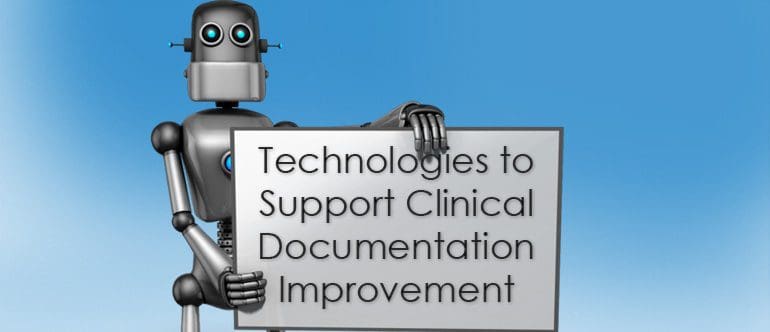Call us toll-free: 800-878-7828 — Monday - Friday — 8AM - 5PM EST

By Dr. Jonathan Elion, MD, FACC for HealthTECH Zone
The Photographic Painting
The value of a new technology is often not understood for many years after its invention. The first film cameras (remember those?) were initially used to capture landscapes, still life studies and portraits. In that regard, they were acting as a “photographic painting”, capturing the standard known subject matter for artists that were using traditional media. It wasn’t until much later that the technology began to realize its full potential in fields as diverse as astronomy, microscopy, high-speed photography and movies.
Computer applications in the Clinical Documentation Improvement (CDI) field are capable of making a similar transformative leap. Rather than simply recreating what we already do today with notes, simple databases and spreadsheets, new technologies allow for totally new workflows, efficiencies, integration, reporting and analysis. Some of these recent trends are starting to have a tremendous impact on CDI.
Rules-Based Expert Systems
An expert system is a specialized type of software that provides answers to problems, eliminating the need to consult a human expert. When applied to a CDI program, the expert system collects and organizes clinical information, examining its own knowledge base and applying its rules, and thereby making its documentation expertise widely available throughout a healthcare organization.
The expert system approach has already been shown to be capable of providing a number of valuable enhancements to CDI, where its rules are applied to the clinical data that has been collected. For instance an expert system could:
- Examine the list of a patient’s medications and laboratory results and suggest additional diagnoses to be considered. This can be as simple as a reminder to add the diagnosis of “hypokalemia” when the serum potassium is low, or to consider congestive heart failure if the patient is taking Furosemide.
- Ask about possible infections when the patient is receiving an antibiotic but there is not a bacterial infection diagnosis listed.
- Identify simple relationships among diagnoses, and make a comprehensive list of suggestions when there is “altered mental status” present.
- Put together more abstract diagnoses such as gastrointestinal bleeding and a low hemoglobin and hematocrit and suggest the user consider anemia, and additional suggestions looking to see if the anemia is caused by the GI bleed.
While an expert system cannot be expected to be better than the human expert, the system provides the ability to automate, process large amounts of information, and to clone the expertise of the human expert. This becomes extremely helpful in improving efficiencies and in training new staff in the subtleties of CDI.
Software as a Service
Providing such an expert system requires that the “knowledge”, or software system, be made available throughout the organization, a goal that is easily accomplished with the use of a hosted data model.
In the past, the use of “Software as a Service” approaches were met with concerns over security and confidentiality, causing many hospitals to return to or stick with a strategy of owning and maintaining their own software and hardware. However, technology and security advances have now made this “hosted data center” approach attractive once again. In addition to greater security, this approach also offers economies of scale and reduced operations and maintenance costs. The technology that underlies a hosted data center ensures that all users have continual access, while securing the patient data, and allowing for the aggregation of data which can be used for benchmarking and comparisons with peer groups. Perhaps the most significant impact of this approach is the elimination of the barrier to entry, as no hardware or software installation is required. New customers can be brought online in a matter of hours instead of weeks or months. For the small hospital, this means access to sophisticated computer systems without the need for a similarly sophisticated IT department. For the large hospital, the burden of managing software licenses and installation is eliminated.
A web-delivered product can also reduce the risks created by rogue programs and viruses on a hospital’s personal computers. Until recently, most applications required the installation of software onto the desktop, which opened the door to malware and made hospital IT departments wary. Today’s advances have eliminated that need, allowing immediate and secure access to data over the web from a browser, and ensuring that all users are running the most current version. Modern browsers can be set to eliminate the local caching of Protected Health Information (“PHI”), further reducing the risk of errant confidential data.
We’ll look at the role that Business Intelligence can play in CDI in In Part 2 of this discussion.
About the Author: Dr. Jonathan Elion, MD, FACC, is a practicing board-certified cardiologist in Providence, RI and an Associate Professor of Medicine at Brown University. With over 40 years of experience in computing and more than 25 years of experience in medical computing and information standards, Dr. Elionhas committed his career to innovations in high value services and healthcare delivery to maximize efficiency and cost effectiveness. Jon is the founder of ChartWise Medical Systems, Inc., a Rhode Island based company that recently introduced ChartWise 2.0. It is the first-to-market interactive software system designed to improve precision in quality clinical documentation and to support revenue assurance through its web-based, comprehensive built-in expertise, electronic queries and robust on-demand reporting.
